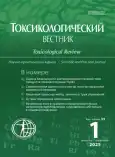Опыт изучения и возможные пути устранения ложноположительных результатов идентификации при проведении анализа пищевых продуктов на содержание запрещённых субстанций методом высокоэффективной жидкостной хроматографии с тандемной масс-спектрометрией
- Авторы: Орлова О.И.1, Корягина Н.Л.1, Савельева Е.И.1, Каракашев Г.В.1, Уколов А.И.1, Радилов А.С.1
-
Учреждения:
- ФГУП «Научно-исследовательский институт гигиены, профпатологии и экологии человека» Федерального медико-биологического агентства
- Выпуск: № 1 (2025)
- Страницы: 58-66
- Раздел: Методы исследований
- Статья опубликована: 15.02.2025
- URL: https://gynecology.orscience.ru/0869-7922/article/view/659798
- DOI: https://doi.org/10.47470/0869-7922-2025-33-1-58-66
- EDN: https://elibrary.ru/ttvesr
- ID: 659798
Цитировать
Полный текст
Аннотация
Введение. Наличие недекларированных производителем запрещённых соединений в специализированных продуктах питания (БАД (биологически активные добавки) и СПП (специализированные продукты питания)) является нарушением Технического регламента Таможенного союза ТР ТС 021/2011 О безопасности пищевой продукции. Разнообразие химических классов запрещённых соединений, их высокая биологическая активность и низкие действующие концентрации определяют необходимость применения высокочувствительных хроматомасс-спектрометрических методов для их обнаружения.
Цель работы – совершенствование методических подходов к идентификации при проведении высокоэффективной жидкостной хроматографии с тандемной масс-спектрометрией (ВЭЖХ-МС/МС-анализ) пищевых продуктов на содержание запрещённых субстанций.
Материал и методы. Исследования проводили методом ВЭЖХ с тандемным масс-селективным детектированием с ионизацией в электроспрее в режиме целевого скрининга. В качестве объектов выступали пробы БАД и СПП.
Результаты. Рассмотрены и классифицированы вероятные источники ложноположительных результатов анализа, приведены примеры из реальной практики. Указано, что основными причинами появления ложноположительных результатов могут быть: близкие значения m/z ионов-предшественников определяемых соединений (разница менее 1 единицы m/z); схожесть структуры исследуемых соединений; исследуемое соединение не образует молекулярного иона-предшественника; матричные эффекты; кросс-контаминация.
Ограничения исследования. Проанализированы 5 основных источников возникновения ошибок идентификации, связанных с неправильной трактовкой масс-спектров.
Заключение и выводы. Решение проблем надёжной идентификации запрещённых соединений в составе БАД возможно путём постоянного развития и совершенствования методологии скрининга, разработки новых методических подходов, оценки их преимуществ и возможных ограничений.
Соблюдение этических стандартов. Исследование не требует представления заключения комитета по биомедицинской этике или иных документов.
Участие авторов.
Орлова О.И. – концепция и дизайн исследования, написание теста, редактирование;
Корягина Н.Л. – обработка материала, написание текста, редактирование.
Все соавторы – утверждение окончательного варианта статьи, ответственность за целостность всех элементов статьи.
Конфликт интересов. Авторы заявляют об отсутствии конфликта интересов.
Финансирование. Исследование не имело спонсорской поддержки.
Поступила: 25 декабря 2023 / Поступила после доработки: 06 мая 2024 / Принята в печать: Опубликована: 25 февраля 2025
Ключевые слова
Об авторах
Ольга Игоревна Орлова
ФГУП «Научно-исследовательский институт гигиены, профпатологии и экологии человека» Федерального медико-биологического агентства
Email: Orlova_oi3@mail.ru
ORCID iD: 0009-0000-6619-2744
Кандидат хим. наук, ведущий научный сотрудник ФГУП «НИИ ГПЭЧ» ФМБА России, 188663, Ленинградская область
e-mail: Orlova_oi3@mail.ru
Надежда Леонидовна Корягина
ФГУП «Научно-исследовательский институт гигиены, профпатологии и экологии человека» Федерального медико-биологического агентства
Email: nkoryagina@mail.ru
ORCID iD: 0000-0001-9486-6558
Кандидат хим. наук, ведущий науч. сотрудник, ФГУП «НИИ ГПЭЧ» ФМБА России, 188663, Ленинградская область
e-mail: nkoryagina@mail.ru
Елена Игоревна Савельева
ФГУП «Научно-исследовательский институт гигиены, профпатологии и экологии человека» Федерального медико-биологического агентства
Email: esavelieva59@mail.ru
ORCID iD: 0000-0002-3115-9626
Кандидат хим. наук, зав. лабораторией аналитической токсикологии ФГУП «НИИ ГПЭЧ» ФМБА России, 188663, Ленинградская область
e-mail: esavelieva59@mail.ru
Георгий Васильевич Каракашев
ФГУП «Научно-исследовательский институт гигиены, профпатологии и экологии человека» Федерального медико-биологического агентства
Email: karakashev58@mail.ru
ORCID iD: 0000-0001-7702-8544
Кандидат биол. наук, ведущий научный сотрудник ФГУП «НИИ ГПЭЧ» ФМБА России, 188663, Ленинградская область
e-mail: karakashev58@mail.ru
Антон Игоревич Уколов
ФГУП «Научно-исследовательский институт гигиены, профпатологии и экологии человека» Федерального медико-биологического агентства
Email: antonukolov@gmail.com
ORCID iD: 0000-0002-2911-1260
Кандидат хим. наук, ведущий науч. сотр., ФГУП «НИИ ГПЭЧ» ФМБА России, 188663, Ленинградская область
e-mail: аntonukolov@gmail.com
Андрей Станиславович Радилов
ФГУП «Научно-исследовательский институт гигиены, профпатологии и экологии человека» Федерального медико-биологического агентства
Автор, ответственный за переписку.
Email: niigpech@rihophe.ru
ORCID iD: 0000-0003-0776-7434
Доктор мед. наук, профессор, и.о. директора ФГУП «НИИ ГПЭЧ» ФМБА России, 188663, Ленинградская область
e-mail: niigpech@rihophe.ru
Список литературы
- Шестопалов А.Е., Ключников С.О., Гришина Ж.В., Берзин И.А., Пушкина Т.А., Жолинский А.В., Кешишян Р.А. Методические рекомендации по нутритивной поддержке у спортсменов-футболистов. Под. редакцией проф. В.В. Уйбы. Москва; 2018.
- Программы энергетического и нутритивнометаболического обеспечения тренировочной деятельности спортсменов высокого класса в условиях их пребывания на базах спортивной подготовки. Методические рекомендации ФМБА России.
- W.A.D. Agency. World Anti-Doping Code 2021. available at: https://www.wada-ama.org (accessed 05.10.2023)
- Рынок БАД в России. Доступно: https://pharmtech-expo.ru/ru/media/news/2023/september/22/biologicheski-aktivnye-dobavki-pharmtech (дата обращения 03.10.23).
- Maughan R.J., Burke L.M., Dvorak J., et al. IOC consensus statement: dietary supplements and the high-performance athlete, Int. J. Sport Nutr. Exerc. Metab. 2018; 28: 104-25.
- World Anti-Doping Agency (WADA). Anti-doping rule violations (ADRVs) report. In., vol. 5–60. World Anti-Doping Agency (WADA). Anti-doping rule violations (ADRVs) report. Montreal: WADA; 2018: 5-60.
- Geyer H., Parr M.K., Koehler K., Mareck U., Schänzer W., Thevis M. Nutritional supplements cross-contaminated and faked with doping substances. J. Mass Spectr. 2008; 43: 892–902. https//doi.org/10.1002/jms.1452
- Martínez-Sanz J.M., Sospedra I., Mañas Ortiz C., Baladía E., Gil-Izquierdo A., Andm Ortiz-Moncada R. Intended or unintended doping? A review of the presence of doping substances in dietary supplements used in sports. Nutrients. 2017; 9: 1–22. https://doi.org/10.3390/nu9101093
- Chen W., Cheng X., Ma Y., Chen N. Foodborne doping and supervision in sports. Food Science and Human Wellness. 2023; 12: 1925–36. https://doi.org/10.1016/j.fshw.2023.03.001
- Federal Law No. 3-FZ dated 08.01.1998 (as amended on 04/28/2023) “On Narcotic Drugs and Psychotropic Substances”. available at: https://mona.fiehnlab.ucdavis.edu/spectra/display/FiehnHILIC000867 (accessed 06.05.2024)
- Appolonova S.A., Shpak A.V., Semenov V.A. Liquid chromatography – electrospray ionization ion trap mass spectrometry for analysis of mesocarb and its metabolites in human urine. Journal of chromatography B. 2004; 800(1–2): 281–9. https://www.lsgeotar.ru/dimedrol-48868.html
- Федеральный закон от 08.01.1998 N 3-ФЗ (ред. от 28.04.2023) “О наркотических средствах и психотропных веществах”.
- лекарственный справочник гэотар. Доступно: https://www.lsgeotar.ru/dimedrol-48868.html (дата обращения 30.03.2022)
- Всемирный антидопинговый кодекс. Международный стандарт. Запрещенный список. 2024. Доступно: https://vk.cc/cIf75W (дата обращения 30.03.2022)
- WADA Technical Document (TD2010IDCR). https://vk.cc/cIf75W (accessed 30.03.2022).
Дополнительные файлы







